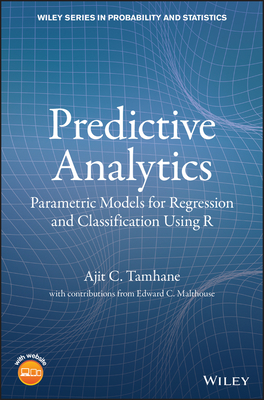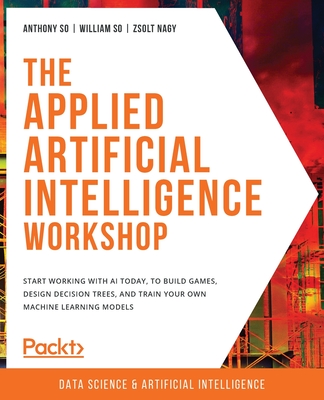Applied Machine Learning
暫譯: 應用機器學習
Forsyth, David
- 出版商: Springer
- 出版日期: 2020-08-14
- 售價: $3,100
- 貴賓價: 9.5 折 $2,945
- 語言: 英文
- 頁數: 494
- 裝訂: Quality Paper - also called trade paper
- ISBN: 3030181162
- ISBN-13: 9783030181161
-
相關分類:
Machine Learning
-
相關翻譯:
機器學習:應用視角 (簡中版)
相關主題
商品描述
A companion to the author's Probability and Statistics for Computer Science, this book picks up where the earlier book left off (but also supplies a summary of probability that the reader can use). Emphasizing the usefulness of standard machinery from applied statistics, this textbook gives an overview of the major applied areas in learning, including coverage of: - classification using standard machinery (naive bayes; nearest neighbor; SVM)- clustering and vector quantization (largely as in PSCS)- PCA (largely as in PSCS)- variants of PCA (NIPALS; latent semantic analysis; canonical correlation analysis)- linear regression (largely as in PSCS)- generalized linear models including logistic regression- model selection with Lasso, elasticnet- robustness and m-estimators- Markov chains and HMM's (largely as in PSCS)- EM in fairly gory detail; long experience teaching this suggests one detailed example is required, which students hate; but once they've been through that, the next one is easy- simple graphical models (in the variational inference section)- classification with neural networks, with a particular emphasis onimage classification- autoencoding with neural networks- structure learning
商品描述(中文翻譯)
機器學習方法現在已成為科學家、研究人員、工程師和學生在各個領域中的重要工具。本書是為那些希望採用和使用機器學習主要工具的人而寫的,但不一定希望成為機器學習研究者。這本教科書適合於最後一年本科或第一年研究生的計算機科學機器學習課程的學生,是一本機器學習工具包。《應用機器學習》涵蓋了許多主題,適合希望利用機器學習過程來完成任務的人,強調使用現有的工具和套件,而不是編寫自己的代碼。
本書是作者的《計算機科學的概率與統計》的補充,接續了前一本書的內容(但也提供了讀者可以使用的概率摘要)。本教科書強調應用統計的標準工具的實用性,概述了學習中的主要應用領域,包括以下內容的涵蓋:
- 使用標準工具的分類(朴素貝葉斯;最近鄰;支持向量機)
- 聚類和向量量化(主要如同PSCS)
- 主成分分析(主要如同PSCS)
- 主成分分析的變體(NIPALS;潛在語義分析;典型相關分析)
- 線性回歸(主要如同PSCS)
- 包括邏輯回歸的廣義線性模型
- 使用Lasso和elasticnet的模型選擇
- 穩健性和m-估計量
- 馬爾可夫鏈和隱馬爾可夫模型(主要如同PSCS)
- EM算法的詳細介紹;長期教學經驗表明需要一個詳細的例子,學生通常不喜歡;但一旦他們經歷過這個,下一個就容易了
- 簡單的圖形模型(在變分推斷部分)
- 使用神經網絡的分類,特別強調圖像分類
- 使用神經網絡的自編碼
- 結構學習
作者簡介
作者簡介(中文翻譯)
大衛·福賽斯(David Forsyth)在開普敦長大。他於1984年獲得約翰內斯堡威特沃特斯蘭大學(University of the Witwatersrand, Johannesburg)的電機工程學士學位(B.Sc. (Elec. Eng.)),1986年獲得該大學的電機工程碩士學位(M.Sc. (Elec. Eng.)),並於1989年獲得牛津大學巴利奧學院(Balliol College, Oxford)的博士學位(D.Phil.)。他在愛荷華大學(University of Iowa)任教三年,之後在加州大學伯克利分校(University of California at Berkeley)任教十年,然後轉到伊利諾伊大學(University of Illinois)。他在2000年、2011年、2018年和2021年擔任IEEE計算機視覺與模式識別會議(Computer Vision and Pattern Recognition, CVPR)的程序共同主席;在2006年擔任CVPR的總共同主席,並在2019年擔任國際計算機視覺會議(International Conference on Computer Vision, ICCV)的總共同主席,還在2008年擔任歐洲計算機視覺會議(European Conference on Computer Vision, ECCV)的程序共同主席,並且是所有主要國際計算機視覺會議的程序委員會的常任成員。他在SIGGRAPH程序委員會服務了六屆。2006年,他獲得IEEE技術成就獎,2009年被評為IEEE會士(Fellow),2014年被評為ACM會士(Fellow)。他於2014年至2017年擔任IEEE TPAMI的主編。他是《計算機視覺:現代方法》(Computer Vision: A Modern Approach)的主要共同作者,這本計算機視覺教科書出版了兩個版本和四種語言。他是《計算機科學的概率與統計》(Probability and Statistics for Computer Science)的唯一作者,該書為本書提供了背景。在各種奇特的愛好中,他是一名強迫症潛水員,持有至常氧三混合氣(normoxic trimix)級別的證照。











